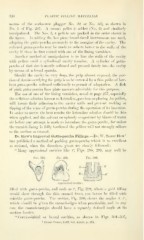Page 332 - My FlipBook
P. 332
:
330 PLASTIC FILLING MATERIALS.
means of tlic corkscrew plugger No. 32 or No. 33), as shown in
No. 1 of Fig. 21)7. A second pellet is added (No. 2) and similarly
manipulated. The Nos. 3, 4 pellets are packed in the order shown in
the figure. In adding the last piece broad-faced instruments are used,
adapting the gutta-percha accurately to the margins of the cavity. The
softened gutta-percha may be made to adhere better to the walls of the
cavity if these be first coated with one of the lining varnishes.
Another method of manipulation is to line the walls of the cavity
Avith pellets vintil a cylindrical cavity remains. A cylinder of gutta-
percha of that size is nearly softened and pressed firmly into the cavity
by means of a broad spatula.
Should the cavity be very deep, the pulp almost exposed, the por-
tion of dentin overlying the pulp is to l)e covered ])y a thin pellet of low-
heat gutta-percha softened sufficiently to permit of adaptation. A disk
of pink gutta-percha base plate answers admirably for this purpose.
The use of one of the lining varnishes, noted at page 257, especially
the cellulose solution known as kristaline, previous to placing the pellets,
will insure their adhesion to the cavity walls and prevent rocking or
tipping of the mass of gutta-percha during the operation of its insertion.
In order to secure the best results the kristaline solution should be thin
when applied, and the solvent completely evaporated by blasts of warm
air before any attempt is made to introduce the gutta-percha, for unless
the varnish lining is fully hardened the j)ellets will not strongly adhere
to the surface so treated.
Dr. How's Improved Gutta-percha Filling-s.—Dr. W. Storer How ^
has published a method of packing gutta-percha which is as excellent
as rational, when the directions given are closely followed
" Many approximal cavities like C, Figs. 298, 299, may well be
Fig. 298. Fig. 299.
-fii"
Approximal cavities.
filled with gutta-percha, and such as C, Fig. 299, where a gold filling
would show through the thin enamel front, can better be filled with
suitable gutta-percha. The section. Fig. 300, shows the angles A, A',
which should be given the enamel-edges when ])racticable, and in any
case the enamel-margin should have a squarely defined angle at its
surface border.
" Cervico-labial or buccal cavities, as shown in Figs. 301-305,
' Dental Cosmos, 1892, vol. xxxiv. p. 281.
330 PLASTIC FILLING MATERIALS.
means of tlic corkscrew plugger No. 32 or No. 33), as shown in
No. 1 of Fig. 21)7. A second pellet is added (No. 2) and similarly
manipulated. The Nos. 3, 4 pellets are packed in the order shown in
the figure. In adding the last piece broad-faced instruments are used,
adapting the gutta-percha accurately to the margins of the cavity. The
softened gutta-percha may be made to adhere better to the walls of the
cavity if these be first coated with one of the lining varnishes.
Another method of manipulation is to line the walls of the cavity
Avith pellets vintil a cylindrical cavity remains. A cylinder of gutta-
percha of that size is nearly softened and pressed firmly into the cavity
by means of a broad spatula.
Should the cavity be very deep, the pulp almost exposed, the por-
tion of dentin overlying the pulp is to l)e covered ])y a thin pellet of low-
heat gutta-percha softened sufficiently to permit of adaptation. A disk
of pink gutta-percha base plate answers admirably for this purpose.
The use of one of the lining varnishes, noted at page 257, especially
the cellulose solution known as kristaline, previous to placing the pellets,
will insure their adhesion to the cavity walls and prevent rocking or
tipping of the mass of gutta-percha during the operation of its insertion.
In order to secure the best results the kristaline solution should be thin
when applied, and the solvent completely evaporated by blasts of warm
air before any attempt is made to introduce the gutta-percha, for unless
the varnish lining is fully hardened the j)ellets will not strongly adhere
to the surface so treated.
Dr. How's Improved Gutta-percha Filling-s.—Dr. W. Storer How ^
has published a method of packing gutta-percha which is as excellent
as rational, when the directions given are closely followed
" Many approximal cavities like C, Figs. 298, 299, may well be
Fig. 298. Fig. 299.
-fii"
Approximal cavities.
filled with gutta-percha, and such as C, Fig. 299, where a gold filling
would show through the thin enamel front, can better be filled with
suitable gutta-percha. The section. Fig. 300, shows the angles A, A',
which should be given the enamel-edges when ])racticable, and in any
case the enamel-margin should have a squarely defined angle at its
surface border.
" Cervico-labial or buccal cavities, as shown in Figs. 301-305,
' Dental Cosmos, 1892, vol. xxxiv. p. 281.


